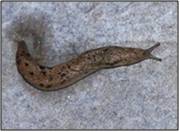SPECIES FACT SHEET COMMON NAME SPOTTED TAILDROPPER VAR
GRAFICOS DE DISPERSION PAIRS(IRIS[14]COLASNUMERIC(IRISSPECIES) )I NVENT A SPECIES PROJECT EXTRA – EXTRA
11 TWENTYFIRST CENTURY SPECIESBEING NICK DYERWITHEFORD PRESENTED AT THE
14 ASYMMETRIC CONSTRAINTS ON LIMITS TO SPECIES RANGES INFLUENCE
1¿CUÁNTAS ESPECIES DE PRIMATES SE CONOCEN EN LA ACTUALIDAD?
3 DATA ANALYSES SUMMARIES DRAFT INVASIVE SPECIES WHICH INVASIVE
SENSITIVE INVERTEBRATE PROFILE
SPECIES FACT SHEET
Common Name: Spotted Taildropper var. pardalis
Scientific Name: Prophysaon vanattae pardalis (Pilsbry, 1948)
Phylum: Mollusca
Class: Gastropoda
Order: Stylommatophora
Family: Arionidae
OR/WA BLM and FS Region 6 Units where Suspected or Documented:
Both the Forest Service and BLM have listed the Spotted Taildropper var. pardalis as a Sensitive Species in Oregon.
The Spotted Taildropper has been documented on three BLM districts in Oregon (CB, RO, SA) and is suspected to occur on a fourth (EU). It is also suspected to occur on one National Forest in Oregon (SIU).
Status:
Natural Heritage Program Rank:
Oregon State Rank: S2; imperiled
List 1 - Threatened or endangered throughout range
Washington State Rank: None
National Rank: N2; vulnerable to extirpation or extinction
Global Rank: G4T2 subspecies; imperiled
State Status:
Oregon State Status: None
Washington State Status: No listing for variety pardalis
Federal Status:
None
Technical Description:
As described by Frest (2000), the Spotted Taildropper var. pardalis is “a rather large slug (often 50-75 mm in length) with pale brown ground color, brown to pinkish brown pigment over much of the body and mantle; sole pale brown; reticulations about equally strong longitudinally and transversely, dividing posterior body into irregular polygons, often with sharp thin black pigment outlining reticulations, but interrupted by irregular, wider black pigment spots; varying numbers of black spots in (mostly small) on the mantle and posterior portions of the body, and sometimes on the sole; mantle stripes generally irregular and interrupted; no dark dorsal stripe; dorsal line very narrow, indistinct, slightly lighter in color than the surrounding flanks; no dark subdorsal bands on the posterior; mantle spotted rather than distinctly striped.”
Steve Dowlan (Mollusk taxa team, 2002) developed the following list of characters that are consistent for specimens of this. The one feature (besides the large size) that seems characteristic of all vouchers for this taxon is the raised light-colored “blister” pattern on the mantle surface. This feature has not been seen in any other Prophysaon.
|
Character |
P. vanattae pardalis |
|
Size |
50-75 mm length |
|
general form |
long acutely tapered tail, appears slightly keeled. Similar to P. foliolatum |
|
mantle stripes |
None |
|
mantle background color |
Black to brownish-black. |
|
mantle surface |
Strongly granulate-rugose, mixed with irregular arrangement of well-defined odd-shaped, light-colored or yellowish, raised “blisters”. |
|
dorsum |
Yellowish background color interrupted by irregular black maculation. A narrow pale mid-dorsal line is sometimes visible, though it may not be complete. |
|
sides |
Variable, generally similar to dorsal coloration. Sides below the mantle may be reactively clear or may be marbled or macualte. |
|
reticulations |
Strongly pigmented black. Very similar pattern to P. foliolatum |
|
foot fringe |
pigmented along pedal furrow, white to cream-white below. |
|
Sole of foot |
cream-white |
|
tail constriction |
not obvious |

Figure 1. Photo of the Spotted Taildropper var. pardalis (Prophysaon vanattae pardalis). Photo © 2005 William Leonard.
Frest (2000) suggests that this may be a valid taxon at the species level, but additional research is needed. If so, the range and habitat would be fairly limited.
Life History:
The spotted taildropper is a terrestrial slug. The biology of this species is not well understood and needs further investigation.
Range, Distribution, and Abundance:
Specimens have been collected from several sites in western Oregon within the Coast Range or on the Pacific Coast, initially suggesting this is a coastal endemic. Other sites have since been located in the foothills of the western Oregon Cascades. The species is generally found as a single specimen at each site (Frest 2000).

Figure 2. Site location map of the Spotted Taildropper var. pardalis (Prophysaon vanattae pardalis) in Oregon. Sites from Frest (2000) and BLM mollusk database (2008).
Habitat Associations:
As described by Frest (2000), the type locality was “In leaf litter under bushes in mature conifer forest at elevation of 600' in east side of Coast Range”. The spotted taildropper is also found in moist, mature forested habitats; or in the coastal fog zone very near the ocean. Sites are relatively diverse in both plant and mollusk species, with a significant deciduous tree or shrub component generally present.
Threats:
Threats to the spotted taildropper include human development, especially along the coast. Habitat is being encroached upon by housing, resort development, beach access, and other human use including recreation. Impacts from logging, grazing, and agriculture are also significant. Frest notes that in addition to the above, certain industries also tend to be associated with a coastal or near-coastal environment. These include cranberry production, boat construction, oyster production, etc. and all of these industries may negatively impact habitat.
Conservation Considerations:
Survey and map all Spotted Taildropper occurrences.
Protect this species’ habitat from further destruction and restore it when opportunities are presented.
Minimize or eliminate conversion of habitat for other uses.
Monitor and assess activities for impacts on the Spotted Taildropper and its habitat.
Monitor the effects of habitat changes on this species.
Minimize grazing access at known sites to protect sites from potential habitat damage.
Protect sites from runoff that may contain residue from insecticide or herbicide applications.
Other pertinent information:
Frest (2000) indicated that this taxon appears to be confined to a narrow area in threatened habitat. No large populations are known, and none have been seen in recent years from the northern half of the range.
Survey Protocol
While the Spotted Taildropper was not a Survey and Manage species, the following is a useful reference for conducting surveys of terrestrial mollusks.
Survey Protocol for Survey and Manage Terrestrial Mollusk Species from the Northwest Forest Plan, Version 3.0 (2003)
http://www.blm.gov/or/plans/surveyandmanage/SP/Mollusks/terrestrial/Mollusk%20document.pdf
Preparer:
Theresa Stone
Umpqua National Forest
30 September 2009
Edited by:
Rob Huff
FS/BLM Conservation Planning Coordinator
January, 2010
References
Frest, T.J. and E. J. Johannes. 2000. Baseline Mollusk Survey of Southwest Oregon (Rogue and Umpqua Basins). Deixis Consultants, Seattle, Washington. Oregon Natural Heritage Program, Portland Oregon.
NatureServe. 2009. NatureServe Explorer: An online encyclopedia of life [web application]. Version 7.1. NatureServe, Arlington, Virginia. http://www.natureserve.org/explorer
Pilsbry, H.A. 1948. Land Mollusca of North America (North of Mexico), Volume II, Part 2. Academy of Natural Sciences of Philadelphia, p. 699.
Turgeon, D.D., J.F. Quinn, Jr., A.E. Bogan, E.V. Coan, F.G. Hochberg, W.G. Lyons, P.M. Mikkelsen, R.J. Neves, C.F.E. Roper, G. Rosenberg, B. Roth, A. Scheltema, F.G. Thompson, M. Vecchione, and J.D. Williams. 1998. Common and scientific names of aquatic invertebrates from the United States and Canada: Mollusks. 2nd Edition. American Fisheries Society Special Publication 26, Bethesda, Maryland: 526 pp.
4 ROLE OF DOSIMETRIC SCALING AND SPECIES EXTRAPOLATION IN
41 A TENYEAR DECREASE IN PLANT SPECIES RICHNESS ON
ACUTE PULMONARY TOXICITY AND PATHOGENICITY [SPECIES] [OR IF
Tags: common name:, 1998. common, common, sheet, spotted, taildropper, species
- CONCEDEN ADOPCIÓN PLENA DE UNA MENOR A PAREJA CON
- ŽÁDOST O REGISTRACI ELEARNINGOVÉ VZDĚLÁVACÍ AKCE ZAŘAZENÍ AKCE DO
- CERIMÔNIA DE ABERTURA DE JOGOS ESTUDANTIS IF LOCAL DATA
- BASES DEL CONCURSO PARA OTORGAR TITULARIDAD A UN ASPIRANTE
- SEMINARIO INTERNACIONAL “LA EXPERIENCIA DE LA ZLAN DE AMÉRICA
- CHILDREN’S SERVICES AND PROPERTY SERVICES GUIDANCE ON CONTRACTORS WORKING
- FORMULARZ DLA OGŁOSZENIODAWCÓW INSTYTUCJA INSTYTUT IMMUNOLOGII I TERAPII DOŚWIADCZALNEJ
- MATERIAL SAFETY DATA SHEET INFECTIOUS SUBSTANCES SECTION I
- CONTRATO DE PRESTACION DE SERVICIOS EDUCACIONALES DUPLICADO – CARPETA
- PARA ACCEDER A ESTE CUESTIONARIO DEBE PONERSE EN CONTACTO
- FORMULARIO PARA LA APROBACION DE UNA POLITICAUN PROCEDIMIENTO TITULO
- REPUBLIKA HRVATSKA MINISTARSTVO HRVATSKIH BRANITELJA OBJAVLJUJE JAVNI
- TOP OF FORM BOTTOM OF FORM 1NUMBER SYSTEMS CONVERSION
- ZESTAW PYTAŃ EGZAMINACYJNYCH NA EGZAMIN DYPLOMOWY CZĘŚĆ WSPÓLNA
- REPEAL OFAMENDED REGULATION 525 FEES FOR ARBITRATORS SECTION 1
- LATVIJAS REPUBLIKA OZOLNIEKU NOVADA PAŠVALDĪBA PIRMSSKOLAS IZGLĪTĪBAS IESTĀDE „ZĪLĪTE”
- AV UNIVERSIDAD VERACRUZANA KM 8 COL STA CECILIA CP
- SCENARIUSZ LEKCJI PISMO ŚWIĘTE – WYJĄTKOWA KSIĘGA 1
- YOUTH ASSOCIATION FOR CHANGE TEL +255788076474 FAX NIL EMAIL
- SENORITA LALALA COPPERKNOB LINEDANCE STEPSHEETS COUNT 32
- 090119 108C127 EARLIEST DATE TO BEGIN WORK (REVISED
- OBRAZAC 1 ERASMUS STUDENT APPLICATION FORM FOR THE ACADEMIC
- BIBLIOTECA DEL DIPARTIMENTO DI STUDI UMANISTICI AUTORIZZAZIONE ALLA CONSULTAZIONE
- LEGAL SERVICES FOR PRISONERS WITH CHILDREN 1540 MARKET STREET
- LA DECONSTRUCCIÓN A FINALES DE LOS AÑOS SESENTA
- 1 VRSTE AUKCIJA OSNOVNA PODELA AUKCIJA MOŽE DA
- CENTRO DE INVESTIGACIÓN EN MATERIALES AVANZADOS DIAGRAMA DE CAUSAEFECTO
- EUSKARAZKO KOMUNIKABIDE ETA IKTEN DIRULAGUNTZA ESKAERA IRABAZI ASMORIK GABEKO
- PRUSICE DNIA………………………………… …………………………………………… IMIĘ I NAZWISKO LUB NAZWA PRZEDSIĘBIORCY
- ESTRUCTURA DESCRIPCIÓN FUNCIÓN NÚCLEO CELULAR NÚCLEO GRAN ESTRUCTURA RODEADA
 INVE WORP ETETÉSI JAVASLAT KOMPLETT TAKARMÁNY KIEGÉSZÍTÉS VEMHES
INVE WORP ETETÉSI JAVASLAT KOMPLETT TAKARMÁNY KIEGÉSZÍTÉS VEMHESCONFERENCE OF CHIEF JUSTICES RESOLUTION 36 REGARDING THE ABA
 ELEKTRO IN RAČUNALNIŠKA ŠOLA PTUJ UPN IN PROGRAMIRANJE V
ELEKTRO IN RAČUNALNIŠKA ŠOLA PTUJ UPN IN PROGRAMIRANJE VANLAGE 1 ZUR DIENSTVEREINBARUNG PERSONENBEZOGENE DATEN 1 2
 PROPOSITIONS POUR LA MISE EN PLACE D’UN PROGRAMME PERSONNALISÉ
PROPOSITIONS POUR LA MISE EN PLACE D’UN PROGRAMME PERSONNALISÉ 1º CONCURSO DE DIBUJO Y PINTURA CON EL LEMA
1º CONCURSO DE DIBUJO Y PINTURA CON EL LEMA ANTSTOLIŲ ALEKSANDRO SELEZNIOVO IR SANTOS SELEZNIOVIENĖS KONTORA S DAUKANTO
ANTSTOLIŲ ALEKSANDRO SELEZNIOVO IR SANTOS SELEZNIOVIENĖS KONTORA S DAUKANTO TEST A KU DEMOKRATYCZNEJ RZECZYPOSPOLITEJ T EST PODSUMOWUJĄCY ROZDZIAŁ
TEST A KU DEMOKRATYCZNEJ RZECZYPOSPOLITEJ T EST PODSUMOWUJĄCY ROZDZIAŁ0 IL PRESIDENTE DELLA SEZIONE CIVILE DELLA CORTE D’APPELLO
TEACHING PERFORMANCE & CERTIFICATION CENTER KEAN UNIVERSITY – COLLEGE
 DIVISION 7 THERMAL PROTECTION 072000 MARFLEX WATERPROOFING & BUILDING
DIVISION 7 THERMAL PROTECTION 072000 MARFLEX WATERPROOFING & BUILDINGWYKAZ PLACÓWEK ZAPEWNIAJĄCYCH MIEJSCA NOCLEGOWE W WOJEWÓDZTWIE MAŁOPOLSKIM (STAN
ЦИБИЗОВА ИМ КИН НС ИНИОН РАН ЧТЕНИЕ В СССР
 PITANJA IZ STATISTIKE U METEOROLOGIJI 1 NAVESTI BAR TRI
PITANJA IZ STATISTIKE U METEOROLOGIJI 1 NAVESTI BAR TRIGENERAL CODE PROVISIONS TABLE OF CONTENTS CHAPTER 1
ARTÍCULO 7 SECCIÓN POLÍTICAS SECTORIALES DIGITALIZACIÓN DE LA ECONOMÍA
A IMPOSSIBILIDADE DA CONCESSÃO DE PARCELAMENTO TRIBUTÁRIO EM CASOS
 ANEXO II DECLARACION RESPONSABLE DE LA EXPLOTACION OBJETO DE
ANEXO II DECLARACION RESPONSABLE DE LA EXPLOTACION OBJETO DECONTRATO DE PRESTACIÓN DE SERVICIOS PROFESIONALES DON CON DNINIF
NA TEMELJU ČLANKA 27 I ČLANKA 50 STATUTA DOMA